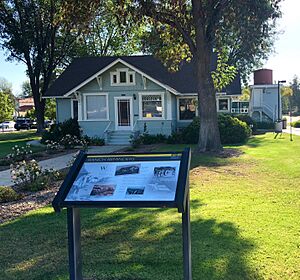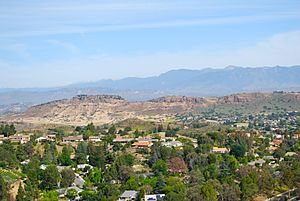Norwegian Colony facts for kids
The Norwegian Colony was a small community of Norwegian families who settled in Thousand Oaks, California, in the 1890s. They were among the very first pioneers to make their home in the Conejo Valley. These families had left their homeland of Norway because it was hard to find land and food there. They first moved to Santa Barbara in 1885. But when they heard about affordable land in the Conejo Valley, they decided to move again in 1890-1891.
The colony was made up of five main families: the Olsens, Andersens (also known as Andersons), Pedersens (also known as Pedersons), Nilsens, and Hansens. Their time in the valley was quite challenging. The Olsen family sadly lost seven of their ten children. Also, Ole Andersen, George Hansen, and Lars Pedersen all passed away within a week of each other in 1901 during a serious illness called diphtheria.
Despite these difficulties, they made an important contribution: the Norwegian Grade. This was a narrow, winding road about 1 mile (1.6 km) long that connected the Conejo Valley to the Santa Rosa Valley. The men and boys of the colony worked hard for two years to build it. Today, the 7-acre (2.8 ha) Spring Meadow Park in Thousand Oaks is dedicated to these early Norwegian settlers.
Contents
Where They Lived
The Norwegian Colony was located in the northeastern part of the Conejo Valley. If you visit California Lutheran University today, you are standing right where the colony once was! The land they settled stretched from Mount Clef Ridge in the north almost down to where Avenida de Los Arboles is now. It went about a mile west from Moorpark Road, reaching the western edges of California Lutheran University.
You can still see signs of these early settlers in Thousand Oaks. Some street names, like Olsen Road and Pederson Road, are named after these Norwegian families. The land where California Lutheran University now stands was actually donated from their original properties.
Their Journey to California
Many Norwegians left their homes in the late 1800s and early 1900s. Life was tough in the fjords of western Norway, with not enough land or food for everyone. Most of the Norwegians who came to Thousand Oaks were from a small village called Stranda, near a large fjord called Storfjorden.
The Norwegian Colony officially began in 1890. Five Norwegian families bought five plots of land in the northern Conejo Valley. They had been living in Santa Barbara for a few years, but they were looking for cheaper farmland. They had thought about buying land at Colonia Rancho, but it was too expensive – three times the price of land in the Conejo Valley!
They bought a total of about 651 acres (263 ha) of undeveloped land from George Edwards. They reportedly paid $3 per acre for flat areas and $2 for hillsides.
- Ole Andersen bought 199 acres (81 ha).
- Lars Pedersen bought 111 acres (45 ha).
- Nils Olsen bought 139 acres (56 ha).
- Ole Nilsen bought 97 acres (39 ha).
- George Hansen bought 105 acres (42 ha).
Their properties were all next to each other, in the area around the intersection of Moorpark and Olsen Roads today, surrounding California Lutheran University. After buying the land, Ole Nilsen traveled back to Norway to bring their fiancées to California. Ole Andersen was the only one who did not get married or start a family.
Challenges and Legacy
As mentioned, the colony faced many challenges. Ole Andersen, George Hansen, and Lars Pedersen all died within a week of each other in 1901. This was due to a serious illness, either typhoid or diphtheria.
Nils and Ellen Olsen went through an even greater tragedy, losing seven of their ten children. Nils built a wooden casket for each child and buried them in a small cemetery on his own land. Their children who passed away were: Paula (age 10) in 1893; Nora (age 6) in 1900; Emma (age 7) in 1903; another Nora (age 5) in 1905; Laura (age 7) in 1908; Ned (age 8) in 1911; and Thora (age 7) in 1912. Only three of their children – Nicolay, Oscar, and Peder Ludvik – lived to become adults.
The Families of the Colony

The five main families and their land plots were:
- Farm Lot #1 (199 acres): Ole Andersen.
- Farm Lot #2 (111 acres): Lars and Karen Pedersen.
- Farm Lot #3 (97 acres): Ole and Elisabeth Nilsen.
- Farm Lot #4 (105 acres): George and Lina Hansen.
- Farm Lot #5 (139 acres): Nils and Ellen Olsen.
Building the Norwegian Grade
Perhaps the most famous thing the Norwegian Colony did was build the Norwegian Grade by hand. These Norwegian settlers were farmers. They needed to transport their cattle and crops like barley and wheat to places like Port Hueneme, Simi Valley, and Moorpark.
The only roads they had to Port Hueneme were long and dangerous. These were the Potrero and Conejo grades in Newbury Park. After George Hansen was badly injured on the Potrero Grade and had to stay in bed for a year, the colony decided to build their own road. They wanted a safer and shorter way to the Santa Rosa Valley. They asked Ventura County for help and received a $60 donation to buy dynamite.
The 1-mile (1.6 km) Norwegian Grade was finished in 1911. Before this road, it took people from Conejo Valley two days to reach Port Hueneme using the Potrero Grade. The new, steep Norwegian Grade cut the travel time by a whole day! A photograph taken by Ellen Olsen of the colony is now on display at the Stagecoach Inn in Newbury Park.
California Lutheran University's Connection
A large part of Lars and Karen Pedersen's original property, about 130 acres (53 ha), was later donated to help establish California Lutheran College in 1959. This donation was made by Richard Pederson, who was Lars and Karen Pederson's son.
Lars Pedersen's first house, built in 1913, is still standing today. It is known as the Pederson House and Water Tower. It is recognized as Ventura County Historical Landmark #45 and Thousand Oaks Historical Landmark #3. This house was built when the Pedersens and Olsens were the only Norwegian settlers still living in Thousand Oaks. It was moved to the corner of Regent Avenue and Faculty Street, about 500 feet (150 m) from where the Ahmanson Science Center is now.



